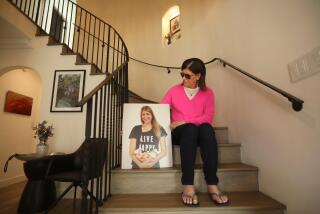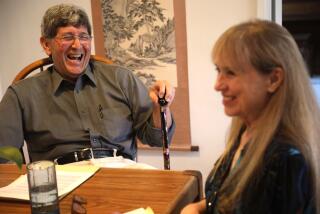Dear Ann (and Mom): This Oneâs for You
I fielded the phone call impatiently. Another earnest PR agent, trying to interest me in her clientâs concern. This one wanted me to write about cancer, the kind of cancer that killed Ann Landers, an under-the-radar variety that too few people know about, and too many people fear.
I cut her off. Too busy, I told her. No one wants to read a column on disease. But she stopped me cold when she said the name: Multiple myeloma.
Thatâs the cancer that killed my mom. The thief that stole my innocence, that left four children motherless, that has shadowed my life ever since.
âWeâre trying to do something to stop it,â said the woman on the phone. And I let her ramble on because I couldnât speak. Because my heart still pounds and eyes grow moist whenever I think about this disease.
Like me, Susie Novis had never heard of multiple myeloma until its diagnosis shattered her dreams. She was an accomplished sales manager, engaged to be married to a successful young executive. Theyâd found the perfect home in Laurel Canyon and planned their lives down to the last detail.
âBrian wanted to increase his life insurance so he had to have a physical,â Novis recalled. âSimple. He was young, healthy. But something was wrong with the blood work. The doctor called. âYou have multiple myeloma. You have three to five years to live,â he said.â
Brian Novis was 33 and not one to give up easily. He made the rounds of medical libraries, researching multiple myeloma, an incurable cancer of the marrow in which uncontrolled growth of plasma cells dissolves surrounding bones and tissues. He enlisted the help of Dr. Brian Durie, one of the countryâs foremost myeloma researchers, and they created a foundation to fund research, share information and provide support for patients living beneath the shroud of the disease.
But the disease pursued him relentlessly. For the next four years, Susie watched him die, his bones disintegrating until the former soccer player shrank from 5 feet 11 to 5 feet 2. From his hospital bed in their living room, he organized the first clinical conference for myeloma specialists. And though he had to strap on protective braces to hold his body together so he could walk, he made it to the groupâs first fund-raiser, in 1992 at the Four Seasons Hotel in Beverly Hills. Most of the few hundred people in attendance were his personal friends.
Six months later, Brian was dead and Susie took over his legacy. Today, the International Myeloma Foundation in North Hollywood has 90,000 members in 64 countries--patients, doctors, caregivers, family members. Its hotline fields calls from all over the globe; it sponsors support groups in dozens of cities; its seminars around the world bring patients and their families together with doctors on the front lines in the fight against the disease.
There are no high-profile myeloma walks or rides or runs for the cure. The foundation has raised $3 million for research mostly through small events--garage sales, carwashes, fashion shows--hosted by families touched by the disease.
The disease has no celebrity spokesperson like Magic Johnson or Michael J. Fox or Betty Ford. Its mortality rate is 100%, and the most famous person to die of myeloma--Eppie Lederer, known as Ann Landers--kept her six-month struggle with the cancer a secret.
But the swelling ranks of sufferers guarantee it wonât stay secret for long. Although it is still relatively rare--the incidence rate is 29 per 100,000 among people 65 and older, and 2 per 100,000 for people younger than 65--myeloma is now considered one of the fastest-growing types of cancer in the world.
More than 14,000 new cases are diagnosed each year in this country as are 1,000 cases a day worldwide. And the number of doctors specializing in research and treatment has jumped from 200 10 years ago, to more than 1,000 today.
âIt used to be weâd say âmyelomaâ and people would say âOh yeah, skin cancerâ [called melanoma],â Novis said. âNow everywhere I go, somebody will ask what I do and Iâll mention âmyelomaâ and they know somebody who died from it.â
And it is no longer considered a disease of the elderly.
Myeloma was once almost unheard of among people younger than 65. But today, 10% to 15% of new cases are among those younger than 45.
That makes early treatment even more essential, so that patients can remain active and bone deterioration can be held at bay.
Much has changed since my familyâs ordeal 26 years ago. Then, there was no Internet, few clinical trials, scanty understanding of a disease that made my motherâs bones so brittle, she was confined to bed and wracked with pain.
At 19, all I knew was that my mother had cancer; that there was nothing that could be cut off or removed, that she was going to die within a few months if she didnât respond to treatment, and within a few years if she did. Eight months later, at 52, she was dead.
The gloomy prognosis hasnât changed much. The average life expectancy for those diagnosed with myeloma still hovers between three and five years. But the percentage of patients living longer is growing and the quality of their lives is much improved, particularly for those who detect their cancer early and start treatment before their bones are destroyed.
Promoting early identification of the disease is one of the foundationâs primary missions, particularly among younger people, who tend to ignore or blame myeloma symptoms--such as bone pain and exhaustion--on overwork or injuries.
A marker of the disease--elevated levels of protein in the blood--is relatively easy to spot in a blood test, and tests far more sophisticated than in my motherâs day can help determine a course of treatment that can delay bone loss and minimize pain.
âBut chances are if youâre a 40-year-old and you have back pain, youâre going to go to an orthopedist or a chiropractor,â Novis said. âYouâre not going to see your family doctor and ask for a blood test âbecause I think I might have cancer.â â
Unless, that is, you are someone like me, who runs to the doctor at the slightest sign that my bones, like my motherâs, have begun to give way. âIt changes your life,â I tell Novis, over lunch. She nods and her face flushes with pain, and we share a long silence full of hard lessons and cruel memories--and hope that, as Brian used to say, âone person can make a difference, and two can make a miracle.â
The International Myeloma Foundation can be reached at (818) 487-7455. Its Web site is www.myeloma.org.
*
Sandy Banksâ column is published Sundays and Tuesdays. Her e-mail address is [email protected].






